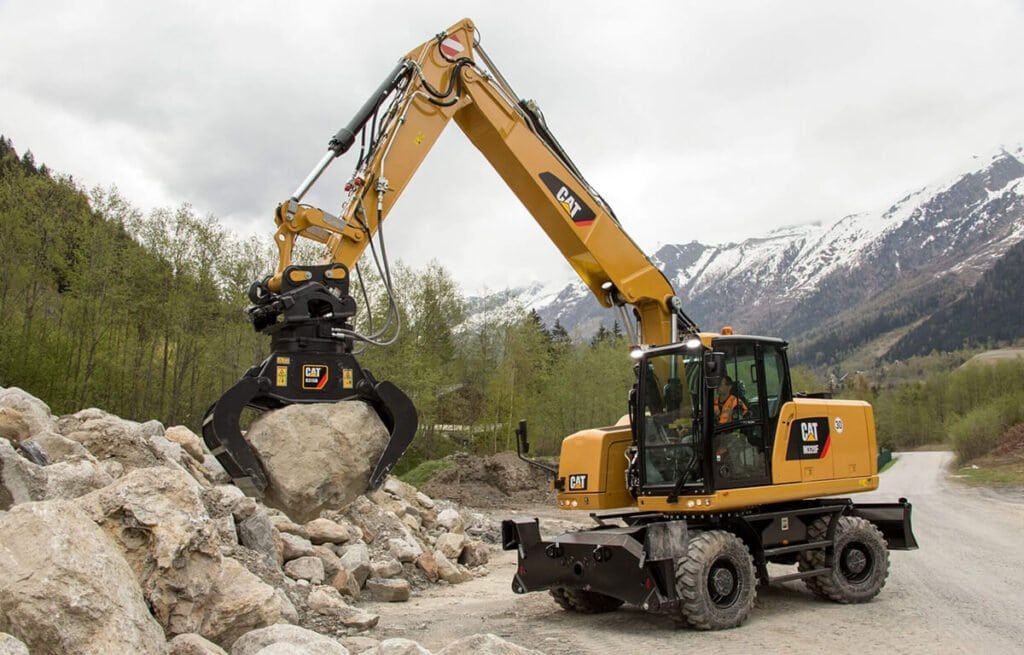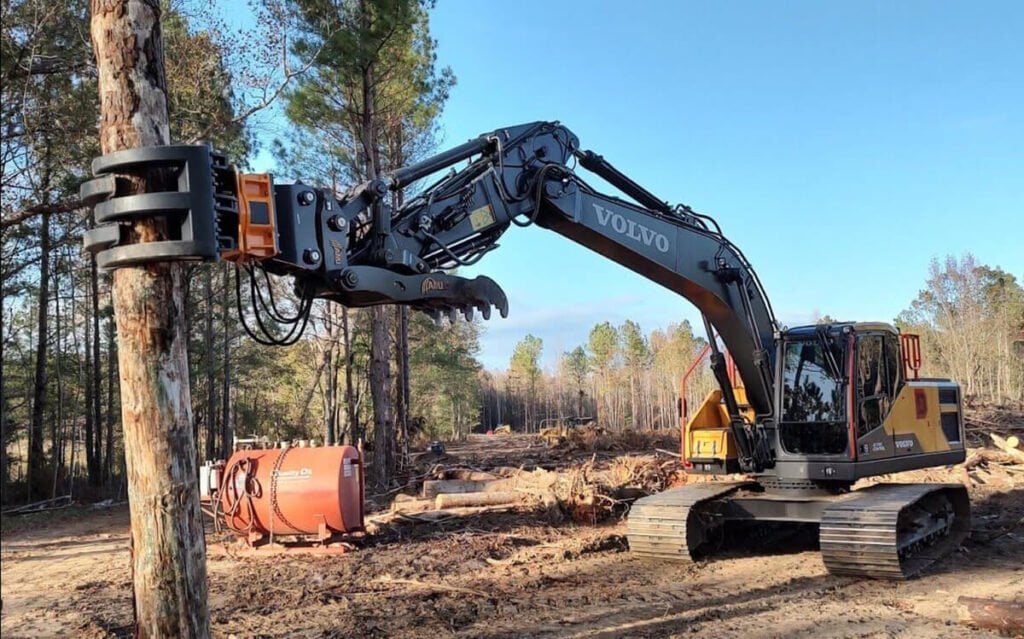In construction, demolition, and material handling, managing large, heavy, or irregularly shaped materials can often become a tedious and time-consuming task. Without the right tools, handling debris, logs, scrap materials, and other bulky objects can lead to inefficiency, increased labor costs, and delays in project completion. This is where an excavator grapple comes into play, providing a practical and effective solution for lifting, moving, and sorting materials with ease.
An excavator grapple is a versatile attachment that attaches to the boom or arm of an excavator, allowing you to handle various materials, such as logs, metal scrap, rocks, and demolition debris. With its powerful gripping mechanism, the grapple provides greater precision and efficiency when moving heavy or awkwardly shaped materials. Whether you’re working on a construction site, recycling facility, or demolition project, the excavator grapple can greatly enhance your machine’s capabilities.
In this article, we’ll explore the features, types, and benefits of using an excavator grapple in your projects. You’ll learn how this attachment can help improve the safety, speed, and efficiency of your operations, making it a must-have tool for anyone involved in material handling tasks.

1. What is an Excavator Grapple?
- Definition: An excavator grapple is a hydraulically operated attachment designed to grip, move, and manipulate various materials. It functions similarly to a claw or claw-like mechanism, which allows it to pick up, carry, and release materials with precision.
- Purpose: The primary purpose of the grapple is to offer an efficient method of handling large or irregularly shaped materials, which are difficult to manage with conventional excavator buckets or tools.
- براعة: Excavator grapples are widely used across different industries, from demolition and construction to forestry and waste management.
2. Types of Excavator Grapples
There are various types of excavator grapples available, each designed for specific applications. The choice of the right grapple depends on the materials you need to handle and the conditions of your worksite.
1.1. Two-Tine Grapple:
- Design: Features two long, strong tines that can be opened and closed to pick up and move large materials.
- Best Use: Ideal for handling bulky materials like logs, steel pipes, and concrete blocks. It’s perfect for forestry, scrap metal handling, and heavy-duty construction.
- المزايا: Strong and durable, can handle heavy materials effectively.
1.2. Four-Tine Grapple:
- Design: Equipped with four tines that offer more gripping surface area, making it suitable for handling lighter, more irregularly shaped materials.
- Best Use: Excellent for handling scrap metal, construction debris, and large piles of waste or soil.
- المزايا: Offers better control, flexibility, and precision when handling a variety of materials.
1.3. Clamshell Grapple:
- Design: This type of grapple has two opposing jaws that close in a clamshell fashion to grip materials. It is commonly used in dredging and material handling operations.
- Best Use: Used for handling materials like rocks, soil, sand, and other bulk items.
- المزايا: Offers a large gripping surface and is highly versatile, ideal for both lifting and sorting.
1.4. Rotating Grapple:
- Design: This grapple has the added feature of rotation, allowing for more precise placement of materials.
- Best Use: Ideal for demolition and sorting tasks where you need to position materials accurately, such as in scrapyards or recycling facilities.
- المزايا: Enhanced control and maneuverability, especially in tight spaces or when working at various angles.

3. Benefits of Using an Excavator Grapple
3.1. Increased Efficiency:
- The excavator grapple allows you to move and manipulate materials faster and more efficiently than manual handling. This is especially beneficial when dealing with large piles of debris or construction materials that need to be moved or sorted quickly. By using the grapple attachment, you can reduce the time spent on labor-intensive tasks and increase overall productivity.
3.2. Reduced Labor Costs:
- By automating material handling with an excavator grapple, you can reduce the need for manual labor, which translates into lower labor costs. Instead of employing a team of workers to move materials by hand or with forklifts, the grapple does the job in a fraction of the time, improving cost-effectiveness.
3.3. Enhanced Precision and Safety:
- Excavator grapples provide greater precision when handling materials, especially in hazardous or confined environments. Whether you are working in demolition, waste management, or forestry, the grapple enables safer handling by reducing human error and minimizing the need for workers to interact with heavy or dangerous materials directly.
3.4. Greater Versatility:
- The versatility of the excavator grapple means it can be used across multiple industries. Whether you’re lifting logs in forestry, handling demolition debris, or collecting scrap metal, the grapple is adaptable enough to perform a range of tasks. Its different designs (such as rotating grapples or multi-tine grapples) also allow for specialized tasks, offering flexibility for a variety of applications.
3.5. Improved Site Organization:
- When used for sorting materials on a job site, the excavator grapple allows you to separate and organize materials more efficiently. This is particularly important in demolition and recycling projects, where materials need to be sorted for disposal, recycling, or reuse. The grapple ensures materials are handled in the correct manner, helping maintain order and streamline operations.

4. Factors to Consider When Choosing an Excavator Grapple
Before investing in an excavator grapple, it’s important to consider several factors to ensure you choose the best model for your needs:
4.1. Size of the Grapple:
- The size of the grapple should match the size of your excavator and the scale of your project. A grapple that is too large or too small for your machine can compromise both performance and safety.
4.2. Material Handling Capacity:
- Consider the types of materials you need to handle and their weight. A grapple with a higher material handling capacity will be more efficient when lifting heavy items like rocks, logs, or scrap metal.
4.3. Durability and Build Quality:
- Look for a grapple made from high-quality, durable materials that can withstand harsh conditions. The durability of the attachment is crucial for long-term use, especially when working in demanding environments.
4.4. Hydraulic Compatibility:
- Ensure the grapple is compatible with your excavator’s hydraulic system. Different models may have varying pressure and flow rate requirements, so it’s important to choose a grapple that matches your machine’s specifications.
4.5. Cost and Value for Money:
- When purchasing an excavator grapple, consider both the initial cost and the long-term value it offers. While it may be tempting to opt for a cheaper model, investing in a higher-quality grapple can save you money on repairs and maintenance over time.

5. Why Choose HIOSEN for Your Excavator Grapple Needs?
At HIOSEN, we offer a wide selection of excavator grapples designed to suit various industries and applications. Whether you’re in construction, demolition, or material handling, we can help you find the right grapple to improve your operational efficiency. Our products are sourced from trusted brands, ensuring you receive reliable, high-quality attachments for your excavator.
This detailed guide covers everything you need to know about excavator grapples, from their types and benefits to the factors you should consider when purchasing one. By choosing the right grapple, you can enhance the efficiency and safety of your material handling tasks, ensuring your construction projects run smoothly.
Get in touch with HIOSEN today to discuss your project needs, explore our product range, and find the perfect excavator grapple for your machine. We’re here to help you improve productivity, reduce costs, and get the job done faster.